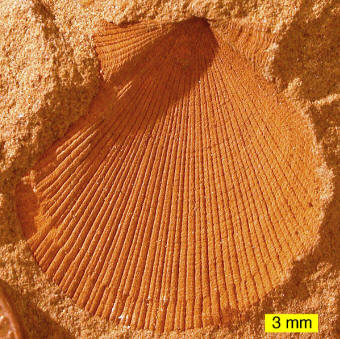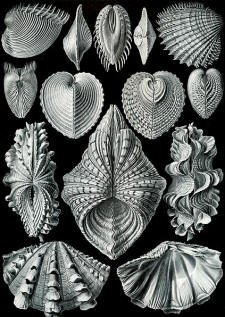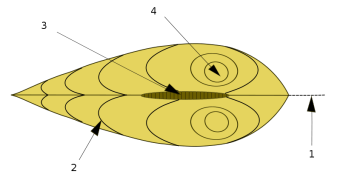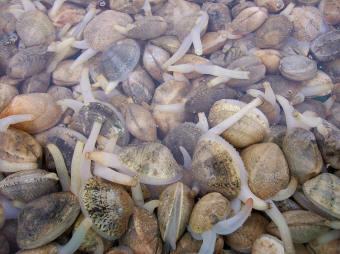|
Bivalve Shell
 |
| Aviculopecten subcardiformis; an extinct pectenoid
bivalve from the Logan Formation of Wooster, Ohio (external mold) |
The shell is composed of two
valves which are hinged together. The shells of marine bivalves commonly
wash up on beaches (often as separate valves) and the shells of freshwater
species can sometimes be found along the flood plains of rivers, and other
freshwater habitats.
Bivalves typically have two-part shells, two valves, that are joined by a
ligament. The two valves usually articulate with one another using
structures known as "teeth" which are situated along the hinge line. In many
(but by no means all) bivalve shells, the two valves are symmetrical along
the hinge line.
This
exoskeleton serves not only for
muscle
attachment, but also for protection from predators and from mechanical
damage. The shell has several layers, and is typically made of
calcium carbonate precipitated out into an organic matrix. It is
secreted by a part of the molluscan body known as the
mantle.
Bivalve shells are collected by professional and amateur
conchologists, and are sometimes harvested for commercial sale (the
international shell trade), occasionally to the detriment of the local
ecology.
Shell Anatomy, Structure and Composition
The bivalve shell is composed of two
calcareous
valves. The
mantle, a thin
membrane surrounding the body, secretes the shell valves,
ligament
and
hinge teeth. The mantle lobes secrete the valves, and the mantle crest
creates the other parts.
The mantle itself is attached to the shell by numerous small mantle
retractor muscles, which are arranged in a narrow line along the length of
the interior of the shell. The position of this line is often quite clearly
visible on the inside of each valve of a bivalve shell, as a shiny line, the
pallial line, which runs along a small distance in from the outer edge
of each valve, usually joining the anterior adductor muscle scar to the
posterior adductor muscle scar. The two adductor muscles are what allow the
bivalve to close the shell tightly.
In some bivalves the mantle edges fuse to form
siphons,
which take in and expel water during
suspension feeding. Species which live buried in sediment usually have
long siphons, and when the bivalve needs to close its shell, these siphons
retract into a pocket-like space in the
mantle. This feature of the internal anatomy of a bivalve is clearly
indicated on the interior of the shell surface as a
pallial sinus, an indentation in the pallial line.
The valves of the shell are made of either
calcite
(as with, e.g. oysters) or both calcite and
aragonite,
usually with the aragonite forming an inner layer, as is the case with the
Pterioida
which have this layer in the form of
nacre or
mother of
pearl.
The outermost layer of the shell is known as the
periostracum, which is composed of a horny organic substance. This forms
a yellowish or brownish "skin" on the outside of the shell.
The periostracum may start to peel off of a shell when it is allowed to dry
out for long periods.
The shell is added to, and increases in size, in two ways - by increments
added to the open edge of the shell, and by a gradual thickening throughout
the animal's life.
The two shell valves are held together at the animal's
dorsum by the
ligament,
which is composed of the tensilium and resilium. The ligament opens the
shells.
Behaviour
The
radical structure of the bivalves reflects their behaviour in several ways.
The most significant is the use of the closely-fitting valves as a defence
against predation and, in
intertidal species,
against desiccation. The entire animal can be contained within the shell,
which is held shut by the powerful adductor muscles. This defence is
difficult to overcome except by specialist predators such as
sea
stars and
oystercatchers.
Feeding
Most
bivalves are
filter feeders
although some have taken up scavenging and predation.
Nephridia remove the waste material. Buried
bivalves feed by extending a siphon to the surface (indicated by the
presence of a
pallial sinus, the
size of which is proportional to the burrowing depth, and represented by
their hinge teeth).
Feeding types
There are four feeding types,
defined by their gill structure:
 |
Protobranchs use their
ctenidia solely
for respiration, and the
labial palps to
feed
|
 |
Septibranchs possess a
septum across the mantle cavity which
pumps in food.
|
 |
Filibranchs and lamellibranchs
trap food with a
mucous coating on
the ctenidia; the filibranchs and lamellibranchs are differentiated by
the way the ctenidia are joined
|
Movement
Razor shells can dig themselves into the
sand with great speed to escape predation. Scallops, and
file clams can swim to escape a predator,
clapping their valves together to create a jet of water.
Cockles can use their
foot to leap from danger. However these methods can quickly exhaust the
animal. In the razor shells the siphons can break off only to grow back
later.
Defensive secretions
The
file
shells can produce a noxious secretion when
threatened, and the
fan shells of the
same family have a unique, acid-producing organ.
Comparison with
Brachiopods
Bivalves are superficially similar to
brachiopods, but the
construction of the shell is completely different in the two groups. In
brachiopods, the two valves are on the dorsal and ventral surfaces of the
body, while in bivalves, they are on the left and right sides.
End of Reading

Return to the
Old Earth Ministries Online Earth
History Curriculum homepage.

Source:
Bivalve
|



